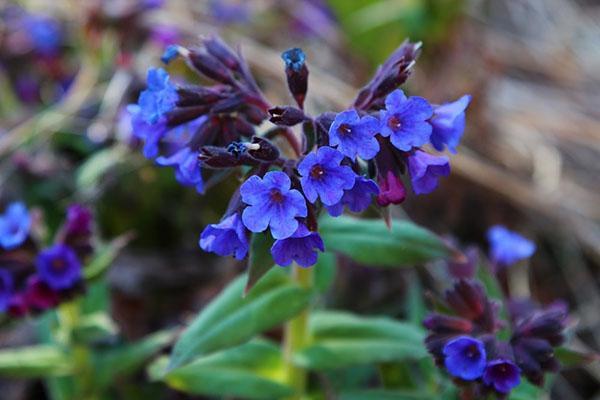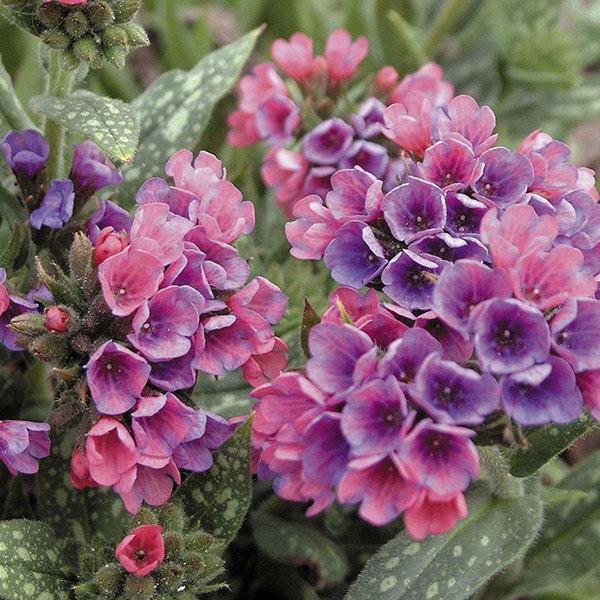Planting and caring for decorative lungwort in the garden at the dacha
 Planting and caring for decorative lungwort is surprisingly very simple, and the plant itself is in great demand among gardeners. The plant belongs to the popular Burachnikov family. Due to its unusual appearance, the flower received other names, such as medunka and pulmonaria. This plant has found its application in folk medicine. Various infusions are often prepared from leaves and flowers, which are used to treat many diseases. Read also about the apple tree lungwort!
Planting and caring for decorative lungwort is surprisingly very simple, and the plant itself is in great demand among gardeners. The plant belongs to the popular Burachnikov family. Due to its unusual appearance, the flower received other names, such as medunka and pulmonaria. This plant has found its application in folk medicine. Various infusions are often prepared from leaves and flowers, which are used to treat many diseases. Read also about the apple tree lungwort!
Description of the plant

This plant is distinguished by a large amount of nectar. It is this feature that attracts bees... It should also be noted that lungwort can be used to make salads. The leaves of this plant are especially famous in the UK. They gained immense popularity due to the presence of useful trace elements that are necessary for the proper development of the body.
The lungwort is a plant whose seeds are spread by ants. This is precisely the reason for the appearance of this type of flower in the most unexpected places.
The plant is rich in:
- tannins;
- saponins;
- tanning components;
- acids (silicic, ascorbic);
- rutin;
- wax;
- flavonoids;
- iron;
- copper.
 The homeland of this species is the lands of Western and Eastern Europe. Some of them can be found in Asia and Siberia. The lungwort appears in early spring, almost immediately after the snow melts. The plant grows well in shade and partial shade. In order for a flower to delight with its flowering for a long time, it is enough to adhere to the elementary rules of care.
The homeland of this species is the lands of Western and Eastern Europe. Some of them can be found in Asia and Siberia. The lungwort appears in early spring, almost immediately after the snow melts. The plant grows well in shade and partial shade. In order for a flower to delight with its flowering for a long time, it is enough to adhere to the elementary rules of care.
Description of sugar honey
 In nature, there are about 70 species of this plant species. But among such a large number, only a few grow in our area.
In nature, there are about 70 species of this plant species. But among such a large number, only a few grow in our area.
One of the most popular varieties is Sugar lungwort. The plant grows in the forests of Italy and France. It is a perennial that has large oval-shaped leaves. In an adult plant, they can grow up to 27 centimeters long and about 10 centimeters wide. The color of the leaves is dark green with silvery blotches.
Funnel-shaped flowers. All of them are collected in inflorescences. A feature of this species is the shade of the buds. The flowering period can last about 30 days. Plant care is very simple. In order for a flower to please everyone around, you do not need to have special skills.
The most popular subspecies:
- Mrs. Moon (dainty leaves and buds of a violet-red hue);

- Dora Barnsfield (this is the fastest growing variety that has light pink flowers);

- Argenta Group (the leaves are almost completely covered with silvery spots, and the flowers are deep purple);

- Silverado (a feature are silvery leaves with a rich green border);

- Opal (a distinctive feature of the Opal lungwort is its bluish leaves, on one stem you can see buds of different shades, but they are mostly white).

There are also other varieties that are bred by Western breeders. They differ not only in their appearance, but also in the rules of care.
Feature of Red and Majestic lungwort
 Red lamb prefers to grow on the hills. The main habitat is the lands of Bulgaria, Hungary and Albania. Often the bush is used as a ground cover herb. The flowering period falls in May and lasts for 30 days. The buds are deep red.
Red lamb prefers to grow on the hills. The main habitat is the lands of Bulgaria, Hungary and Albania. Often the bush is used as a ground cover herb. The flowering period falls in May and lasts for 30 days. The buds are deep red.
The red louse has long rhizomes that can grow very quickly. Leaves are light green in color. Their length can reach 15 centimeters. All plates are abundantly covered with fine bristles.
Variegated varieties of lungwort have abundant flowering that can last for several months.
Lungwort Majestic is the most popular variety. The plant is very difficult to confuse with other species. The flower is distinguished by light green leaves, which acquire a golden hue closer to summer. The flowers are pink at first, but turn blue over time. The plant is resistant to various weather conditions. The bushes do an excellent job with low temperatures and winter well.
Majestic is the most unpretentious flower that can grow well even in the shade. With proper care, the flower can reach 30 centimeters in height and up to half a meter in diameter. The first buds can be seen in May.
Description of the lungwort Leopard and Mrs Kittle
 It is an attractive perennial plant that is a subspecies of Sugar lungwort. The height of the flower can range from 15 to 30 centimeters. The width of the bush reaches about 35 centimeters.
It is an attractive perennial plant that is a subspecies of Sugar lungwort. The height of the flower can range from 15 to 30 centimeters. The width of the bush reaches about 35 centimeters.
Medunits Leopard is covered with two types of deciduous plates. Basal are rather large. They can grow up to 27 centimeters long. The width of the bottom plates is 10 cm. The root plates are elliptical. They are attached to long stalks of a dark green hue. Stem leaves are sessile. They grow small. The color of the upper plates is bright green with light spots.
The flowers of the Leopard lungwort, like other varieties, are funnel-shaped. All of them are collected in racemose inflorescences. On the same plant, buds of different shades can be found. They often take on a pink to purple tone.
The flowering period of this species is in May. Fruits, in the form of seeds, ripen at the end of July. Ripe grains break into 4 parts, from which young plants grow.
Mrs Kittle's lungwort is a hybrid species. The height of an adult plant reaches 35 centimeters.
Flowers can be from light pink to lavender. Deciduous plates are long. They take on a dark green color with silvery spots.
Planting and caring for decorative lungwort in the open field
 In order for this plant not only to look beautiful, but also to bloom profusely, it is necessary to properly plant it. This procedure involves the choice of time and place. The further development of the flower depends on these moments.
In order for this plant not only to look beautiful, but also to bloom profusely, it is necessary to properly plant it. This procedure involves the choice of time and place. The further development of the flower depends on these moments.
Boarding time
 The best month for this procedure is early April. It is during this period that the soil is most saturated with nutrients that are necessary for the proper development of the lungwort.
The best month for this procedure is early April. It is during this period that the soil is most saturated with nutrients that are necessary for the proper development of the lungwort.
This plant does not like waterlogged soil, therefore, planting should be carried out in soil that dries well after winter.
Landing place
 Compared to other outdoor plants, lungwort is unpretentious in lighting. She feels good both in partial shade and in the shade. When planting and caring for lungwort flowers, remember that the plant is very afraid of direct sunlight.
Compared to other outdoor plants, lungwort is unpretentious in lighting. She feels good both in partial shade and in the shade. When planting and caring for lungwort flowers, remember that the plant is very afraid of direct sunlight.
The best place is considered to be a site near trees.You can also plant a plant from the north of the building. This placement will protect the delicate leaves from direct sunlight, which can lead to burns.
 When planting a plant, remember that it does not like too moist soil. If the flower is in the lowland, then the lungwort should be transplanted to the garden bed, which will be located at the very top of the site.
When planting a plant, remember that it does not like too moist soil. If the flower is in the lowland, then the lungwort should be transplanted to the garden bed, which will be located at the very top of the site.
Soil preparation
This type of flower develops well on any soil. But, despite this, it is best to choose loamy soils with low acidity. Sandy loam soil with a high percentage of humus is also considered a good option. Don't forget about drainage before planting. A good layer of pebbles or crushed red bricks must be laid at the bottom of the recess.
Bushes should be planted at a distance of about 25 centimeters from each other. Such indicators are due to the fact that the lungwort is able to grow, thus covering everything around with itself.
Fertilization
 As for feeding, this should be done in July. It was during this period that the plant most of all needs fertilization... It is best to use liquid mineral products. They need to be diluted at the rate of 20 grams of the drug per bucket of water.
As for feeding, this should be done in July. It was during this period that the plant most of all needs fertilization... It is best to use liquid mineral products. They need to be diluted at the rate of 20 grams of the drug per bucket of water.
Each flower needs some care, and lungwort is no exception. Although the plant is not demanding, you still need to follow the rules.
Irrigation
 Too much moisture can adversely affect flower development. Therefore, watering the bush should be done when urgently needed. The number of procedures should be increased only in the hot season. This is especially true of Red lungwort. Due to a lack of moisture, its leaves lose their elasticity and rather quickly begin to wither and dry. In order not to cut off drooping shoots, it is necessary to water the plant every day during a drought.
Too much moisture can adversely affect flower development. Therefore, watering the bush should be done when urgently needed. The number of procedures should be increased only in the hot season. This is especially true of Red lungwort. Due to a lack of moisture, its leaves lose their elasticity and rather quickly begin to wither and dry. In order not to cut off drooping shoots, it is necessary to water the plant every day during a drought.
Mulching
An important procedure to be carried out in the spring. The soil around the bush should be covered with mulch. To do this, only natural materials must be used.
A good option is:
- wood chips;
- dry grass;
- peat, sawdust.
Thickness mulch should be about 15 centimeters. It is this amount of it that can protect the roots from overheating and drought. Also, mulching materials will serve as a good fertilizer and will not allow weeds to spread.
Pruning plants
Care and cultivation of lungwort includes the removal of leaves. This procedure should be carried out immediately after the plant has faded. Remove the arrows on which the buds were located should be done only with a sharp knife. It is necessary to cut off in such a way that there is no hemp left from the peduncle. It is also recommended to closely monitor the presence of dry leaves. When yellow plates appear, they must be cut off immediately. This will not only allow the bushes to look neat, but also prevent the spread of fungal diseases.
It is forbidden to pick off yellow leaves, as this can harm the shoots.
As for wintering, before the onset of cold weather, it is recommended to cover the plant with a special canvas. This should be done in the first year of the lungwort's life, since the young bush has not yet adapted to sudden changes in temperature.
Flower propagation
 In order to grow a young plant, you do not need to have certain skills. There are a number of methods that make it very easy and simple to propagate lungwort.
In order to grow a young plant, you do not need to have certain skills. There are a number of methods that make it very easy and simple to propagate lungwort.
The best option is:
- division of the bush;
- rhizome segments;
- seeds.
 The propagation of lungwort by the first method is used mainly for the Sugar variety. To do this, in the fall, you need to separate several parts from the bush. It is important to make sure that each of them has kidneys. Each plant should be placed in the soil about 4 centimeters deep.
The propagation of lungwort by the first method is used mainly for the Sugar variety. To do this, in the fall, you need to separate several parts from the bush. It is important to make sure that each of them has kidneys. Each plant should be placed in the soil about 4 centimeters deep.
The division of the rhizome is more effective, since this method allows you to preserve all the varietal qualities of the flower.A similar procedure should be carried out in the spring. Each separated piece should be trimmed and planted in the ground at a distance of about 30 centimeters.
Seed propagation is used by few. This is due to the fact that it will be extremely difficult to preserve the characteristics of the variety. If you want to experiment, then you can use this method and you can get a unique variety that will not be similar to any of the existing species.
Proper planting and care of lungwort in the open field is the key to a beautiful plant. If you follow the above rules, then the flower will delight you with colorful buds and a pleasant aroma for a long time.